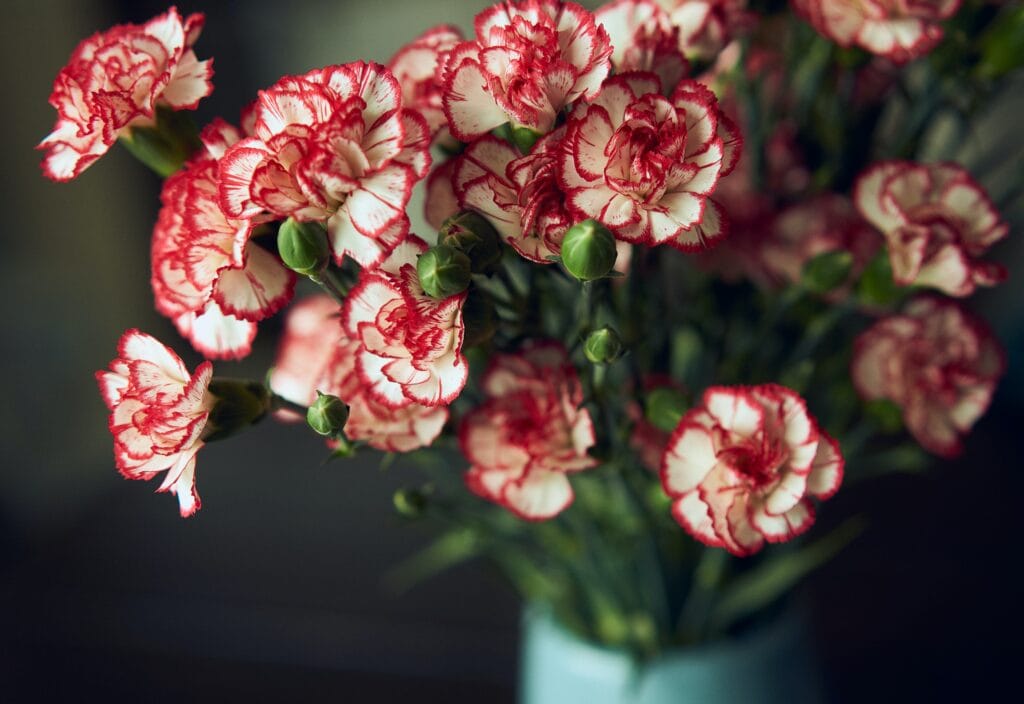Flowers have long been celebrated for their beauty, fragrance, and the joy they bring to special occasions and everyday life. However, for some, certain flowers can be a source of discomfort due to allergic reactions.
While many are familiar with common allergens like tree or grass pollen, few are aware of potential allergens hidden in their favorite bouquets. Understanding which flowers can trigger allergies is crucial, especially for those with respiratory concerns or sensitivities.
Among the flowers available in florists and gardens, carnations are a popular choice for many. Their ruffled petals and wide range of colors make them a favorite for bouquets, weddings, and other celebratory events.
But do carnations cause allergies?
In this article, we are discussing everything related to carnations, their potential allergenic properties, and how you can enjoy their beauty without compromising your health.
What You’ll Learn in This Article:
- The basic characteristics of carnations
- Do carnations cause allergies and factors contributing to allergic reactions?
- How carnations compare to other commonly allergenic flowers.
- Practical precautions to take if you have flower allergies or sensitivities.
By the end of this article, you’ll have a comprehensive understanding of the relationship between carnations and allergies, allowing you to make informed decisions about your floral choices.
Let’s get into it!
Do Carnations Cause Allergies?
Yes, but while carnations can cause allergic reactions in some individuals, they are generally considered to be low on the allergenic scale compared to other flowers.
Carnations, like many other flowers, produce pollen. However, the structure and amount of pollen they release can vary.
When discussing allergies, especially those related to plants and flowers, the primary culprit is often pollen. Pollen grains are tiny, powdery particles released by plants for reproduction. For many, these grains can become airborne irritants, leading to allergic reactions when inhaled or when they come into contact with the skin.
Here are some key points to consider:
Pollen Structure
Carnations have relatively heavy pollen grains, which means they are less likely to become airborne and inhaled. This reduces the chances of respiratory allergic reactions.
Pollen Amount
Not all carnations are prolific pollen producers. Many modern varieties, especially those used in floral arrangements, are bred to produce minimal pollen.
Symptoms
Those who are allergic to carnations might experience symptoms like sneezing, runny or stuffy nose, itchy or watery eyes, and skin rashes. It’s essential to note that these symptoms can vary in intensity from person to person.
While carnations are not the top allergenic flower, it’s always a good idea to exercise caution, especially if you or someone you know has a history of allergies. Being informed and taking preventive measures can make a significant difference in ensuring comfort and well-being.
Comparing Carnations to Other Common Allergenic Flowers
When choosing flowers, whether for personal enjoyment or gifting, it’s beneficial to understand how different flowers rank in terms of allergenic potential. While we’ve established that carnations are generally low on the allergenic scale, how do they compare to other popular flowers?
Here’s a breakdown of some commonly allergenic flowers and how carnations stack up against them:
- Ragweed: Often mistaken for harmless wildflowers or herbs, ragweed is a significant allergen. Its lightweight pollen can travel for miles, making it a primary cause of hay fever.
- Chrysanthemums: These popular blooms can cause allergic reactions in some individuals due to the presence of a naturally occurring chemical called sesquiterpene lactone.
- Daisies: Similar to chrysanthemums, daisies can also trigger allergies because of sesquiterpene lactone. Those sensitive to one are often sensitive to the other.
- Sunflowers: While sunflowers are bright and cheerful, their pollen can be an allergen for some. It’s advisable for allergy sufferers to opt for pollen-free varieties.
- Lilies: Some people might experience skin irritation or respiratory symptoms when exposed to lily pollen, especially when the orange pollen-bearing anthers are touched.
Carnations, in comparison, have a lower likelihood of causing allergies due to their heavier pollen grains and the reduced pollen production in many modern varieties. However, it’s essential to remember that individual reactions can vary, and what might be harmless to one person could be problematic for another.
When selecting flowers, especially for indoor spaces or gifts, it’s always a good idea to consider the potential allergenic properties. Being informed can help ensure that your floral choices bring joy without unintended discomfort.
If you are concerned about your or your loved one’s sensitivity to particular flowers, it’s worth considering a breathing & lung function test. This test can provide the clarity and peace of mind you need to enjoy flowers without worrying about potential allergic reactions.

Precautions for those with Allergies
For those with known allergies or sensitivities, being around flowers can be a double-edged sword. Here are some practical steps to minimize the risk of allergic reactions:
Choose low-pollen flowers
Opt for flowers known to produce minimal pollen. As we’ve discussed, while carnations can cause allergies in some, many modern varieties are bred to produce less pollen. Other low-pollen flowers include roses, tulips, and orchids.
Keep Flowers out of bedrooms
To ensure a good night’s sleep without allergic interruptions, it’s best to keep flowers out of sleeping areas. Pollen can easily spread, and bedrooms should be kept as allergen-free zones.
Regularly change vase water
Stagnant water can become a breeding ground for mold, another common allergen. Ensure you change the water in flower vases every couple of days to keep it fresh and mold-free.
Handle with care
If you’re arranging flowers or handling them for any reason, consider wearing gloves. This can prevent direct contact with pollen and reduce the risk of skin reactions.
Use air purifiers
If you love having flowers indoors, investing in a good air purifier can help reduce airborne allergens, ensuring cleaner air in your living spaces.
Stay informed
If you’re unsure about your sensitivity to certain flowers or pollen, a breathing & lung function test can be invaluable. Such tests can provide insights into your respiratory health and potential triggers, allowing you to make informed decisions.
By taking these precautions, you can create a balance between enjoying the beauty of flowers and maintaining your health and comfort. Remember, being proactive and informed is the key to a harmonious relationship with the floral world.
Conclusion
Flowers, including carnations, bring beauty and joy to our lives. However, the potential for allergic reactions is a reality for some individuals. While carnations are generally on the lower end of the allergenic scale, it’s essential to be informed and take precautions to ensure health and comfort.
In conclusion, by understanding the allergenic properties of flowers and making informed choices, one can enjoy their beauty without compromising well-being. Being proactive and knowledgeable is the key to a harmonious relationship with the floral world.
If you or a loved one are experiencing symptoms or suspect that carnations or other flowers might be causing allergies, it’s essential to seek expert advice. At Arizona Allergies Associates, our dedicated team of specialists is here to help. Contact today to schedule your appointment.



